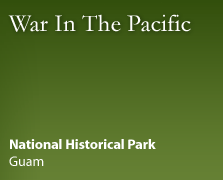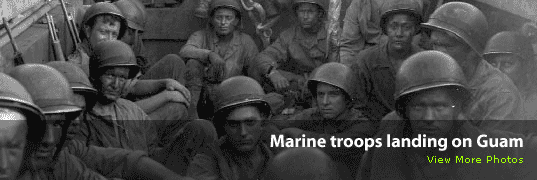| |
Ga'an Point in Agat was part of the southern landing site of the US forces in the liberation of Guam on July 21, 1944. The southern landing area encompassed from Bangi Island to Apaca Point. This area was strategically chosen in order to help secure Orote Peninsula to the north. Orote Peninsula was important because of the airfield and entrance to Apra Harbor as a supply port. The plan was to overtake Ga'an Point, where the entire beach front at Agat could be used to offload supplies and equipment that were critical for the inland advance. The Japanese 38th Regimental Combat Team had command post headquarters at Mt. Alifan and the Japanese forces heavily fortified the area from Facpi Point to Agat Bay. The Japanese defense weapons placed at Ga'an Point included a single-barrel, Japanese dual purpose 25 mm machine cannon and a 20cm short barrel naval gun, a 25mm machine cannon, and a double-barreled anti-aircraft gun. The Japanese also had extensive defenses consisting of numerous pillboxes built in coral outcroppings, and concrete blockhouses that held a 75mm and 37mm gun to fire upon the beaches. A Japanese inscription can be seen today in the concrete blockhouse.
On July 21, 1944 the first wave of the Southern Landing Force invaded Guam in Agat. The 1 st Provisional Marine Brigade consisted of the 4th Marine Division and the 22nd Marine Division. The4 th Marines were to storm onto Beach Yellow #1 and #2 and to establish a beachhead and protect the flank of the brigade and then proceed to secure Mt. Alifan. The 22 nd Marines after landing at Beach Yellow #1 and #2 were to secure Agat Village and drive north and cut off Orote Peninsula. Agat village was to the north of where it is established today, and nothing remains of the original village. The next wave of soldiers was the 77th Army Infantry Division, which consisted of the 305th Regimental Combat Team. The 305 th Regimental Combat Team landed later that day at 1400. They waded ashore because there were no LVT’s (Landing Vehicle Tractors) available. The 305th Regimental Combat Team was to make a passage of lines of the 4th Marine Division and protect that sector of the beachhead. The fighting at Agat was severe and it took 3 days to firmly establish the southern beachhead. On July 24, 1944 the reported losses of US forces numbered near 1,000. The island itself was not declared secure until August 10. 1944. The total casualties for the Japanese forces from July 21-Aug 10, 1944 are over 10, 900.
The historic resources that remain intact at Gaan Point include the stronghold. This stronghold was built into the rock outcropping and was heavily camouflaged and was the reason so many US soldiers lost their lives. The concrete blockhouse consists of the casemates for a 75mm gun and a 37 mm gun. The interior of the 75 mm casemate has internal damage indicating it was fired upon from the rear. The pillbox located just north of the stronghold also housed a 75mm gun. This structure also has an observation post on top of it. There are two guns on display near the beach. One is a 25mm anti-aircraft gun. This gun used high explosive ammunition and could fire 300 rounds a minute. This gun is typical of the type of gun used by the Japanese throughout the island. The second gun is a 20cm coastal defense gun. These guns were used to fire at troop ships and landing craft. Approximately 20 other guns like this were found in Japanese defensive positions after the recapture of Guam.
|
|





